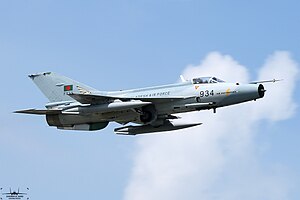
Back تشنغدو جيه-7 Arabic চেংদু জে-৭ Bengali/Bangla Chengdu J-7 Czech Chengdu J-7 German Chengdu J-7 Spanish چنگدو جی-۷ Persian Chengdu J-7 Finnish Chengdu J-7 French चेंगडू जे-7 Hindi F–7 Hungarian
| J-7 / F-7 Airguard | |
|---|---|
 Bangladesh Air Force F-7BGI in 2018 | |
| General information | |
| Type | Fighter aircraft |
| Manufacturer | Chengdu Aircraft Corporation/Guizhou Aircraft Industry Corporation |
| Status | Operational |
| Primary users | People's Liberation Army Air Force (China) |
| Number built | 2,400+[citation needed] |
| History | |
| Manufactured | 1965–2013 |
| Introduction date | 17 January 1966 |
| Developed from | Mikoyan-Gurevich MiG-21 |
| Developed into | Guizhou JL-9 |
The Chengdu J-7 (Chinese: 歼-7; third generation export version F-7; NATO reporting name: Fishcan[1]) is a Chinese fighter aircraft. It is a license-built version of the Soviet Mikoyan-Gurevich MiG-21, and thus shares many similarities with that aircraft.[2] The aircraft is armed with short-range, infrared homing air-to-air missiles and is mainly designed for short range air-to-air combat. The aircraft is also used for close air support.
On 30 March 1962, the Soviet Union and China signed a technology transference arrangement pertaining to the MiG-21. Allegedly, while various kits, components, completed aircraft and associated documents were delivered to the Shenyang Aircraft Factory, the design documentation was incomplete, and Chinese designers made efforts to reverse engineer the aircraft. While the two aircraft are greatly similar, areas of difference include the hydraulic systems and internal fuel arrangements. During March 1964, domestic production of the J-7 reportedly commenced at the Shenyang Aircraft Factory, but due to various factors including the Cultural Revolution, mass production was only truly achieved during the 1980s. Numerous models of the J-7 were developed, featuring improvements in areas such as the armament, avionics, and wing design.
The aircraft is principally operated by the People's Liberation Army Air Force (PLAAF), but numerous international operators have bought their own J-7s. Outside of China, the largest operator of the J-7 is the Pakistan Air Force. Later generation Chinese aircraft, such as the Shenyang J-8 interceptor, were developed with the lessons learned from the J-7 programme. Several nations, including Zimbabwe, Tanzania, and Sri Lanka, deployed the type in offensive roles.
In 2013, production of the J-7 was terminated after the delivery of 16 F-7BGI to the Bangladesh Air Force. Newer fighter aircraft, such as the JF-17 Thunder and Chengdu J-10 multirole fighters, have succeeded it in the export market. To date, large numbers of J-7s remain in service with multiple export customers,[3][4] with PLAAF retiring the fleet in 2023.[5]
- ^ "CHINA EQUIPMENT" (PDF). Office of Naval Intelligence. United States Office of Naval Intelligence. Archived (PDF) from the original on 19 June 2018. Retrieved 19 June 2018.
- ^ J7, Sino Defence, archived from the original on 16 July 2006.
- ^ Medeiros, Cliff, Crane and Mulvenon 2005, p. 162.
- ^ "China's Expert Fighter Designer Knows Jets, Avoids America's Mistakes". International Relations and Security Network. Archived from the original on 2 October 2015. Retrieved 4 September 2015.
- ^ "China to retire the J-7 fighter this year". Alert 5. 30 January 2023.